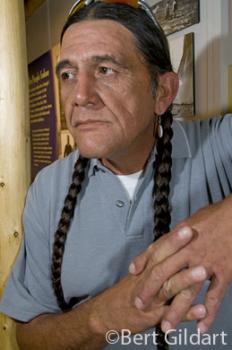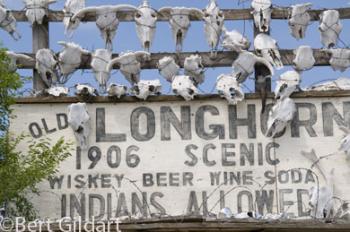Should A Part of Badlands NP Be Returned to the Lakota? Some Think So.
©Bert Gildart: According to Enos Poor Bear, the South Unit of Badlands National Park has always belonged to the Lakota [Sioux] People.

Enos Poor Bear
“That land is ours,” said Poor Bear, “because of the Treaty [1868] of Fort Laramie. Congress removed the South Unit from the Reservation so they could use it as a bombing range. That was 1940. They did away with bombing in the 1960s but then the government gave jurisdiction of it to the National Park Service rather than to us, the Lakota People.”
WE HAVE A STORY TO TELL
Though it seemed to both Janie and me when we talked several days ago to Poor Bear that anger would have been justified, such wasn’t the case. In a very dispassionate tone he explained his role as an interpreter for the national park service, working out of the White River Interpretive Center in the park’s South Unit.
He continued, telling about the hopes the Lakota now have of seeing this portion of the Badlands returned to them.
“Not much would change,” said Poor Bear, “except we would manage this portion of the park–and the money would go to us, rather than being split now with the National Park Service. We’d enter a legal agreement with the National Park Service so access would remain the same…
“We have a story to tell here, and we believe we can do it very effectively.”
A CONVINCING CASE
Two day ago we met a variety of people from the reservation, and without exception all were gracious, despite the fact, the people have a history of being at odds with the wider society.

"Indians Allowed"
We met Joe Whiting, once a tribal policeman. And we met Reginald Hollow Horn, who was a young boy of nine when the second Wounded Knee Occupation occurred in 1973.
Whiting explained how the animosity of the two cultures dates back to the infamous slaughter at Wounded Knee, and it’s certainly a part of the history of the Badlands. Who could ever tell it better than people on the reservation, something Whiting elaborated on where we met him at the mass burial of around 300 Lakota, all killed or fatally wounded on a brutally cold December day in 1890.

Joe Whiting
The tragedy traces its origin to a time when Wovoka, a spiritual man, began generating a following soon to be known as the Ghost Dancers. The group believed that by wearing a certain type of shirt, they would make themselves immune to the bullets of cavalry soldiers. They believed that once again the land they had cherished as a bison hunting culture would revert to them.
WOUNDED KNEE MASSACRE
But that wasn’t to be. On the morning of December 29, 1890 soldiers heard the continued chanting of the Lakota. Fears continued to mount, and the soldiers stirred themselves up, believing the dancing represented the beginning of a massive uprising. Then a rifle accidentally discharged and the soldiers began firing into a group of unarmed men, women and children led by Chief Spotted Elk, also known as Big Foot. At the time Big Foot was in his lodge suffering from pneumonia.
Before the “battle” was over soldiers killed over 300, resulting in what has infamously been called the Battle of Wounded Knee. Soldiers were also killed, but nearly all by “friendly fire.”
There was, of course, a second siege at Wounded Knee in 1973 that lasted for months, but we now heard first hand the story from Joe who was a BIA policeman at the time.
“The reservation was torn up in those days,” said Joe. “AIM occupied the church and some of those people were my relatives. And they were shooting guns.

Reginald Hollow Horn
“At night they’d sneak over to my house to sleep. Next morning we’d feed them, then they’d return to the church by day. And, of course, we were supposed to be at odds with them. It made the times very difficult for us; those were our relatives.”
Reginald Hollow Horn also knows the story and he graciously took time to explain the bullet holes that still dent the church walls, many around the cross. He gave us his time despite the fact his grandmother had just passed away and was lying in state in an outbuilding near the church.
BULLET HOLES IN CHURCH
Hollow Horn was the third person we had randomly bumped into and without exception, all were gracious to us despite the fact we would be here but for a few days while gathering story for Rich Luhr and his Airstream Life Magazine.
We hope the Lakota are given the much overdue opportunity to tell their story.
By treaty the land was theirs, and only because of supposed military needs was the land taken away. Now the Lakota people have the opportunity to better manage their own affairs and tell the story of Indian history and of the world-class fossils some of the land contains.
By agreement they would continue working with the national park service who will help tell the story of the area’s great trove of paleontological finds.
But the Lakota believe they can tell the story of the area’s history better than any one else, and if the type of people we randomly met yesterday is any indication of the types of Native American who could soon be telling that story, then it seems both societies would benefit.
Post From This Time last Year on: Training For Mount Rainier

